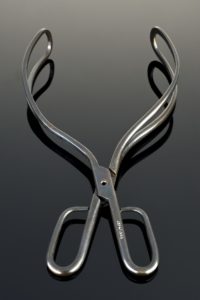Cerebral Palsy Caused by Forceps Delivery or Vacuum-Extraction
Sometimes, the birth of a child doesn’t go as smoothly as planned. In such cases, doctors may make executive decisions to use certain methods to help free the baby in order to avoid fetal asphyxia or distress, which can lead to lifelong complications.
These assistive methods include the use of forceps and/or a suction-cup-like vacuum — used on the baby’s head, body, or shoulders — in order to direct it through the the birth canal. That said, the incorrect or negligent use of these birth aids can lead to severe complications such as skull fractures, brain damage, and the development of cerebral palsy.

Obstetrical Forceps
Why Doctors Use Forceps and Vacuum Extractors
Assisted delivery tools such as forceps and vacuum extractors are sometimes used in the second stage of labor, often when a mother is fatigued. When the mother is unable to help push with enough force (or the child becomes stuck for any reason), doctors may decide that the best way to proceed is by using assisted delivery tools.
Forceps are surgical instruments that look like giant spoon-shaped tongs, which are generally used to grab hold of the baby’s head. In tandem with each contraction, the doctor should gently guide the child through the canal in a downward fashion.
Vacuum extraction (also referred to as “Ventouse” or VE) is more-commonly used than forceps these days. These assistive tools are equipped with a soft suction cup that sticks to a child’s head with a small pump for suction. An “Odón device” is similar to VE, but uses a plastic sleeve which is inflated around the circumference of the baby’s head. These types of assisted vaginal delivery tools are also typically used in conjunction with pushing by the mother.
When NOT To Use Forceps and Vacuum Extraction
Forceps aren’t usually the best course of action for difficult childbirth unless needed as a last resort. Certain conditions make it dangerous to use them, and the potential risk to the child can be extremely serious.
Delivery forceps have been known to cause cephalohematomas, subgaleal hemorrhages, damage the cranial nerves, and even skull fractures. Premature babies are especially-susceptible to brain bleeds, and children with connective tissue conditions (as well as those with skeletal demineralization) are at a higher risk of suffering complications should doctors use forceps.
Vacuum extraction should never be performed on children born before the 35th week of gestation or if there is a risk of fetal bleeding. If the child’s head is too large to fit through the pelvis, a C-section should be performed.
Doctors know to identify such potential delivery issues early on so that the obstetrician/gynecologist can delivery the child safely and efficiently. Failing to identify these risk factors can lead to serious birth injuries, and may constitute medical malpractice.
Birth Injuries Caused by Malpractice
Generally speaking, physicians should exercise great caution when utilizing any assisted vaginal delivery tools, and they should always consider the option of a C-section since it is statistically much safer. Assisted delivery tools are generally only employed in the case of a medical emergency such as a cord prolapse, fetal distress, or uterine rupture — all of which can jeopardize the health of both the mother and child.
Children who develop cerebral palsy as a result of the improper or negligent use of these tools will go on to suffer lasting effects. Cerebral palsy can affect a child’s movement, muscle tone, cognitive abilities, speech, hearing, and even sight. Children with CP often require extensive physical therapy, mobility devices, and some children may even require round-the-clock care. This can be an expensive undertaking for most families, as it’s estimated that the cost of raising a child born with cerebral palsy can easily exceed $1 million.
If you believe that a doctor’s malpractice ultimately caused your child to develop cerebral palsy, you need to discuss your legal options with a cerebral palsy attorney. Through a birth injury claim, your family may be able to recover the compensation you’ll require to give your child every chance at success.
